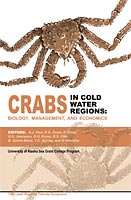
Observations on rearing red king crab (Paralithodes camtschaticus) zoeae and glaucothoe in a recycling water system
N. Kovatcheva
- Price: $0.50 Sale: $0.00
 This is part of Crabs in Cold Water Regions: Biology, Management, and Economics
This is part of Crabs in Cold Water Regions: Biology, Management, and Economics| Format | Price | |
|---|---|---|
| PDF download [303.6 KB] Bypass cart and download |
Free | Add to Cart |
Description
First-time results of rearing red king crab (Paralithodes camtschaticus) zoeae and glaucothoe in a closed, recycling, artificial seawater (CRAS) system are discussed. Four red king crab females with developing embryos were taken April 1, 2000 in Peter the Great Bay (Sea of Japan). Ovigerous females were transported by air to Moscow and were kept in a 2,000 L glass CRAS system. Rearing of zoeae and glaucothoe over the next 60 days were also studied in smaller CRAS systems (200 L). During the whole period, zoeae (Z-I to Z-IV) and glaucothoe (G) were fed on Artemia salina nauplii. By 36-38 days (288-304 degree-days) post hatching, the zoeae (Z-IV) had passed metamorphosis and transformed into glaucothoe. Survival rate through four zoeal stages averaged about 40%. At 8.0 to 10.0ºC, development from the beginning of the zoea I stage to the first juvenile crab (C-1)stage averaged 57 days or 494 degree-days. Survival through glaucothoe (G) was 10.4%.
This is the first time red king crabs were reared in artificial seawater from embryonic development stages to juveniles in Russia. Studies will be continued to optimize conditions for cultivation of red king crab larvae and glaucothoe in CRAS systems.
Item details
- Item number: AK-SG-02-01v
- Year: 2002
- DOI: https://doi.org/10.4027/ccwrbme.2002.22



